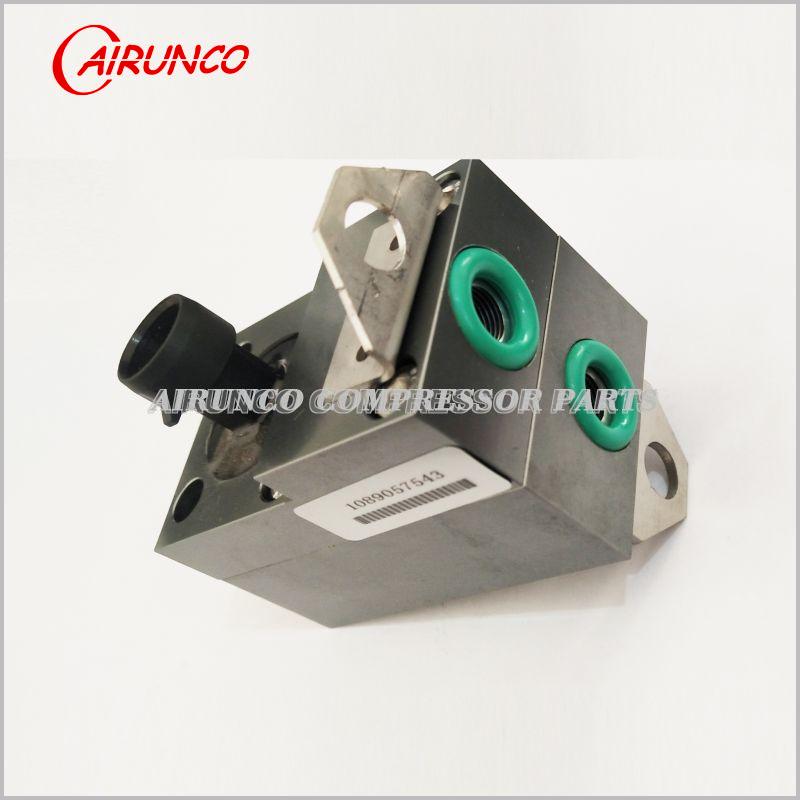Transducer 1089057543 Pressure Sensor Air Compressor Parts 1089-0575-43
Air Compressor Spare parts Accessory Classification:
Sensors: Temperature sensor, Pressure sensor.
Controllers: Computer board, Relay board, PLC controller, Controller, Control panel, Operation panel.
Valves: Solenoid valve, Rotary valve, Pneumatic valve, Blow-off valve, Temperature control valve, Thermal control valve, Temperature control valve core, Proportional valve, Capacity control valve, Pressure maintenance valve, Inlet valve, Safety valve, Regulating valve, Expansion valve, Check valve, Shuttle valve, Pipeline filter, Automatic drain valve, Water filter cup, Pressure relief valve, Pressure regulator.
Filters and Oil: Air filter, Oil filter, Oil separator, Lubricating oil, Pipeline filter, Automatic drain valve, Water filter cup.
Main Unit: Main unit (compressor head), Bearings, Shaft seals, Bushings, Gears, Gear shafts, Overhaul kits.
Maintenance Kits: Main unit, Unloader valve maintenance kit, Pressure maintenance valve, Rotary valve, Temperature control valve core, Inlet valve, Coupling elastomers, etc.
Cooling: Fan, Radiator, Heat exchanger, Oil cooler, Aftercooler.
Switches: Pressure switch, Temperature switch, Emergency stop switch, Pressure differential switch.
Transmission: Coupling, Elastomers, Spider couplings, Elastic blocks, Gears, Gear shafts.
Hoses: Inlet hose, High-pressure hose.
Starter Plate: Contactor, Thermal protector, Reverse-phase protector, Terminal block, Relay, Transformer, etc.
Buffers: Shock absorber pad, Expansion joint, Expansion valve, Elastomers, Spider couplings, Elastic blocks.
Instruments: Timer, Temperature switch, Temperature indicator, Pressure gauge, Pressure regulator.
Motors: Permanent magnet motor, Variable frequency motor, Electric motor.
Analysis of Screw Air Compressor Faults:
Symptom: High Oil Consumption or High Oil Content in Compressed Air
Possible Causes:
Excessive cooling oil volume, which should be observed during unit loading, with the oil level within the normal range.
Damage to the oil-gas separator.
Blockage in the secondary oil return pipe.
Poor oil quality.
Long-term use of the precision filter without replacement.
High oil temperature, leading to excessive oil content in the working air.
Symptom: Low Unit Pressure
Possible Causes:
Actual air consumption exceeds the unit output.
Malfunction of air release or intake valves in the screw air compressor (valves cannot close during loading).
Abnormal transmission system.
Excessively high ambient temperature.
Air filter blockage.
Malfunction of the load solenoid valve (1SV).
Minimum pressure valve stuck.
Leaks in the user pipeline network.
Malfunctioning pressure sensor, pressure gauge, pressure switch, etc.
Screw wear and faults leading to low unit pressure.
Leakage in the pressure sensor or pressure gauge input hose.
Symptom: Overloaded Fan Motor
Possible Causes:
Deformation of fan blades.
Faulty bearings in the fan motor.
Malfunction of the thermal relay in the fan motor (aging).
Loose connections.
Voltage below the rated voltage.
Symptom: High Unit Current
Possible Causes:
Operating voltage lower than 5% of the rated voltage.
Supply cable too long or with a smaller diameter.
Loose connections.
Unit set pressure exceeds the rated pressure.
Blockage in the oil separation core.
Relay failure.
Main unit malfunction.
Main motor malfunction.
Fault Phenomena of Air Compressor:
Symptom: High Discharge Temperature (Exceeding 100°C)
Possible Causes:
Low coolant level in the unit (should be visible through the oil sight glass but not exceed half).
Dirty oil cooler, indicated by the temperature difference between the inlet and outlet oil ports. A normal temperature difference is between 20-30 degrees Celsius. If external dust blocks the heat dissipation, compressed air can be used to blow dry. If internal dirt in the radiator cannot be blown off, professional cleaning agents (such as heavy oil pollution cleaning agents, propane, or dust removal) may be required. If the radiator is severely blocked, it needs to be cleaned by circulating clean water pump. For water-cooled radiators, the best method is to disassemble the front and rear covers and clean the inside of the copper tubes with an iron rod.
Symptom: High Oil Consumption or High Oil Content in Compressed Air
Possible Causes:
Excessive coolant volume, which should be observed during unit loading, with the oil level not exceeding half.
Blockage in the return oil pipe.
Improper installation of the return oil pipe (distance from the bottom of the oil separation core).
Low discharge pressure during unit operation.
Rupture of the oil separation core.
Damage to the baffle inside the separator body.
Oil leakage in the unit.
Deterioration or expired use of the coolant.
High temperature.
Symptom: Low Unit Pressure
Possible Causes:
Actual air consumption exceeds the unit output.
Malfunction of the air release valve (cannot close during loading).
Malfunction of the intake valve.
Abnormal transmission system, excessively high ambient temperature, clogged air filter.
Faulty load solenoid valve (1SV).
Stuck minimum pressure valve.
Leaks in the user pipeline network.
Low pressure setting.
Malfunction of the pressure sensor (Intellisys control unit).
Faulty pressure gauge (relay control unit).
Faulty pressure switch (relay control unit).
Leakage in the pressure sensor or pressure gauge input hose.
Possible Causes:
Malfunction of the intake valve.
Hydraulic cylinder failure.
Faulty load solenoid valve (1SV).
Excessive pressure setting.
Malfunction of the pressure sensor (Intellisys control unit).
Faulty pressure gauge (relay control unit).
Faulty pressure switch (relay control unit).
Symptom: High Unit Current
Possible Causes:
Low voltage.
Loose connections.
Unit pressure exceeds rated pressure.
Blockage of the oil separation core.
Relay failure.
Main unit malfunction.
Main motor malfunction.
Symptom: Unit Unable to Start
Possible Causes:
Blown fuse.
Faulty temperature switch.
Loose connections.
Operation of the main motor thermal relay.
Operation of the fan motor thermal relay.
Transformer failure.
No power input to Intellisys (Intellisys control unit).
Failure to resolve the fault (Intellisys control unit).
Faulty Intellisys controller.
Symptom: High Current or Tripping During Unit Startup
Possible Causes:
User air switch issue.
Low input voltage.
Short interval for star-delta conversion (should be 10-12 seconds).
Hydraulic cylinder failure (not resetting).
Intake valve malfunction (too wide open or stuck).
Loose connections.
Main unit malfunction.
Main motor malfunction.
Failure of the 1TR time relay (relay control unit).
Symptom: Overloaded Fan Motor
Possible Causes:
Deformed fan.
Fan motor failure.
Failure of the fan motor thermal relay (aging).
Loose connections.
Radiator blockage.
High exhaust resistance.


















